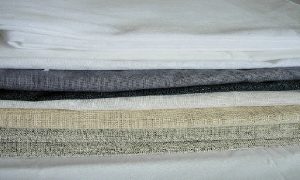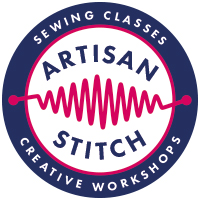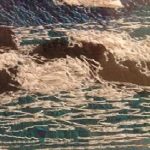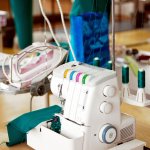Interfacing Types and Uses
Interfacing is another fabric layer that is applied to areas of a garment to shape, strengthen and support the main fabric. It is used on waistbands, collars, cuffs, and shirts plackets. It is normally applied to the facing rather than to the main garment piece.
Choosing the correct variety for the job is crucial as the wrong one will ruin the look of the garment. Use a weight that is the same or lighter than the main fabric, but never heavier. Interfacing is available in many variables:
- woven, non-woven or knitted
- weight
- fusible or sew-in
- colour
Always carry out a test to check that it’s suitable before using on your garment. Ensure that it doesn’t show from the right side, and that it doesn’t affect the colour, texture, drape or handle of the main fabric.

Woven
Must be treated the same as the garment pieces i.e. cut on the same grain, and it’s useful where there are bias-cut pieces as it will retain the ‘give’.
Non-woven
Has no grain so can be used in any direction. However it will restrict the bias movement on a fabric. Therefore woven interfacing used in the same direction as the main fabric pieces would be more appropriate.
Knitted
For use on knitted fabrics where the stretch qualities need to be retained. Apply so the interfacing ‘grain’ runs in the same direction as the fabric.
Colour
The colour of non-woven interfacing is limited to white/off white or black/charcoal so choose the one closest to your fabric i.e. white for light fabrics, dark for dark fabrics. If your fabric is a strong mid-tone, say red, then hold a piece of each colour against the fabric to check if there is any ‘shine through’. Tailoring canvas is also available in beige or grey tones.
Fusible interfacing
This is coated with a fine layer of glue on one side. It will look shiny, or there will be tiny raised bobbles which you’ll feel if you rub your fingers over. Ensure this side goes face-down onto the wrong side of the fabric. The glue is activated by heat and moisture so use a steam iron to apply. Fusibles cannot be used with fabrics which are heavily-textured such as knobbly tweed. A sew-in variety should also be used with fabrics that are damaged by heat, moisture or pressure such as velvet, acetates, or some silks.
To apply fusible interfacing, position it face down onto the wrong side of the fabric. Use the tip of the iron to spot fuse to hold in place. Then fuse the whole piece working from one side to the other. Placing a damp cloth between the iron and the interfacing helps the bonding process and prevents any glue transfer onto the iron. Apply using a patting motion so as not to cause the interfacing to move, then press more firmly and hold, allowing the iron to do the work. Check that the edges and corners are firmly bonded, and if not, then repeat the fusing process. Turn the piece over and press again from the right side to draw the adhesive further into the fabric for a better bond.
Sew-In interfacing
This should be used where the fabric is either very fine or very heavy, or when using tailoring techniques to shape and mould fabrics. In addition to purpose-made interfacing, other fabrics such as silk organza, fine cotton or even another layer of the garment fabric can be used to stabilise the main pieces. The fibre content of the two fabrics can be different but the weight and care requirements must be compatible. To apply a sew-in interfacing, cut the interfacing the same shape and size without trimming seam allowances. Machine tack the two layers just beyond the seamline, using a loose stitch. Do not backstitch. Construct the garment following pattern instructions, using the two layers as one.










